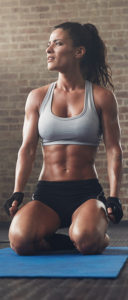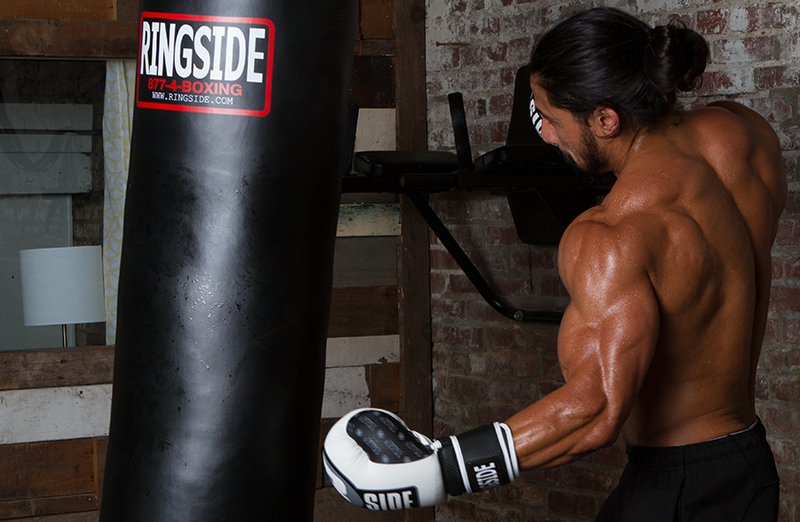 Core strength is the unsung hero of a fighter’s physical development. It is the link in the chain that transfers strength and power from the legs to the arms and fists.
Core strength is the unsung hero of a fighter’s physical development. It is the link in the chain that transfers strength and power from the legs to the arms and fists.
It is the central platform that provides stability to a fighter’s defensive movements.
It is the engine that powers a fighter through round after round of constant motion.
In every aspect of the game the success of a boxer relies on core strength.
Read on to learn how core strength fuels your in-ring performance. You can also see what kinds of exercises will help you build your core for maximum benefit in the ring.
Benefits of a Strong Core for Boxing

Punching Power
We’ve talked a bit before about how Punching Power begins in the legs and feet. But in order to transfer the power from one’s lower body, a boxer must have a strong core.
A boxer’s core is a key link in what’s known as the kinetic chain. Every part of your body links with one another to pass energy into a boxer’s punch. But the chain is only as strong as its weakest part. It requires a strong, stiff set of core muscles (the abs, the hips, and the lower back) in order to pass as much energy as possible into the punch.
Stability and Control

Have you ever watched a fighter dodge a punch by simply shifting their torso? A boxer like Sweet Pea Whitaker could lean back, roll to the side, or duck down to avoid an incoming attack. You better believe that defensive moves like that depend on having a strong, flexible core.
Your core muscles support and stabilize your entire upper body. When these muscles are strong, you effectively move your center of gravity lower, allowing you to shift your body in any direction and adjust to the actions of your opponent.
If your core is weak, then you will find yourself off-balance in situations where you need to change position quickly. If won’t matter how fast your feet are, if your upper body cannot stay balanced in response to your footwork.
Increased Endurance
Just about every move you make activates the core. Reach up to grab an object off the shelf? You use your core. Sit down in a chair or stand up again? You use your core. Dance around the ring throwing punches and dodging attacks? You betcha, you’re using your core.
So if you’re core is underdeveloped, then all that movement in the ring is going to wear you out quickly. You’ll be expending energy to keep your core engaged when it’s not used to that kind of activity. You’ll find yourself out of juice no matter how many miles you’ve run.
If you’ve focused on building strength and stamina in your core muscles, though, you’ll find that these movements feel effortless. You simply flow without having to expend much energy at all. You’ll be able to go harder for longer.

Building a Strong Core for Boxing
For a boxer, building core strength is about both stamina and explosive power. Low-intensity exercises like planks will build that base strength. Core muscle endurance makes your movements easy and allows you to keep dipping and slipping for the whole match.
High-intensity exercises like the Russian Twist will build the ability to execute explosive rotation of your upper body when punching. This is how you maximize the energy transfer of the kinetic chain.
You’ll also want to incorporate compound movement exercises that engage your core along with a variety of muscle groups. This builds integrated, functional strength. This helps you engage your core in the complex movements that you’ll likely experience in the ring.
Low-Intensity: Building the Base
Plank Pose
The plank pose is a great exercise for building stamina in the slow-twitch fibers of your abs.
To do the plank pose, you put yourself into the top of a push up and hold for 15 to 60 seconds. You need to keep your legs and back straight. Don’t sag your hips or push up into a bend. Engage your core muscles and breath evenly for the duration.
V-Sit Pose
This exercise is a bit more dynamic than the plank pose, but still involves holding a single position for an extended period.
In this case, you begin sitting on the floor. Lift both legs up to 45 degrees. Reach forward with your hands to stabilize your position. Hold here, balancing on your pelvis for 15 to 60 seconds.

Crunches
Crunches are a classic abdominal strengthening exercise. They’re probably also something that you’ve done a million times so far in your boxing training. But that’s only because they are both super simple and extremely good at developing core stamina.
Lay on the ground with your knees bent. You can also lay on a fitness ball to provide more support for your lower back while also forcing you to engage more of your core muscles. With your arms folded across your chest, squeeze your abs together to pull your shoulders and upper back off the ground, and your chest toward your knees. Then lay your upper body back down.
High-Intensity: Explosive Rotation
Russian Twists
Lay down on the floor with your legs bent at 45 degrees. It might be helpful for this exercise if you brace your feet under something or have a partner hold them down.
Raise your upper body off the floor, forming a V-shape. Extend your arms out in front of you, then twist to your side until your arms are parallel with the floor. Hold for a second, then twist to the other side. Hold. Return to center.
Bicycle Crunches

Bicycle crunches work a similar set of muscles as do the russian twists, but it’s a more dynamic exercise. It’s going to engage the muscles in a different way than the controlled movements of the previous exercise.
Start by laying on your back with both legs extended and raised slightly off the floor. Put your hands to the side of your head with your elbows straight out. Bring your right knee in and rotate your upper body to bring your left elbow up to touch it. Then alternate.
Wall Ball Throw
Now we’re getting into the kind of explosive movements that start to resemble what it’s like to throw a punch.
Start standing with your feet shoulder width apart facing a wall about thee paces away. Pick up a wall ball and hold it straight out in front of you. Twist to your right side. Rotate your arms so that they are parallel to the wall, with the right arm directly above the left. Then throw the ball as hard as you can at the wall, rotating your body back to center. Catch the ball and repeat the movement by rotating to your left side.
Functional Movements: Putting it All Together
Squats
Squats are great functional movement that engage your core muscles while also strengthening your legs and glutes.
Stand with your feet about shoulder width apart, with your toes pointed slightly outward. Squat down, keeping your back straight, your hips pulled back, and your weight balanced between your heels and the balls of your feet. When your hips are level with your knees, hold for one to three seconds. The push up quickly back into a standing position.

Deadlifts
Where the squat focuses on your lower body, the deadlift focuses on your upper body while also engaging your core.
Step up to your barbell with your feet under the bar about shoulder width apart. Bend over the bar and grip it, overhand. Bend your knees until your shin almost touches the bar. Keep a neutral spine, a flat back, and engage your core. Push down through your feet as you lift up the bar. When the bar passes your knees, push your hips forward to stand up straight. Reverse the movement to return the bar to the floor.
Bent Dumbbell Lateral Raise
Now this exercise requires you to engage the core to remain stable, but really works all of the back muscles.
Stand with feet shoulder width apart. Bend over at the waste, engaging your core to maintain a flat back. Reach down to grab a dumbell in each hand. With your arms fully extended, raise them out to your sides so that they are parallel to the floor. Return your arms to their starting point.


Marquez definitely comes to mind as one who deserves to be mentioned in the list of elite!